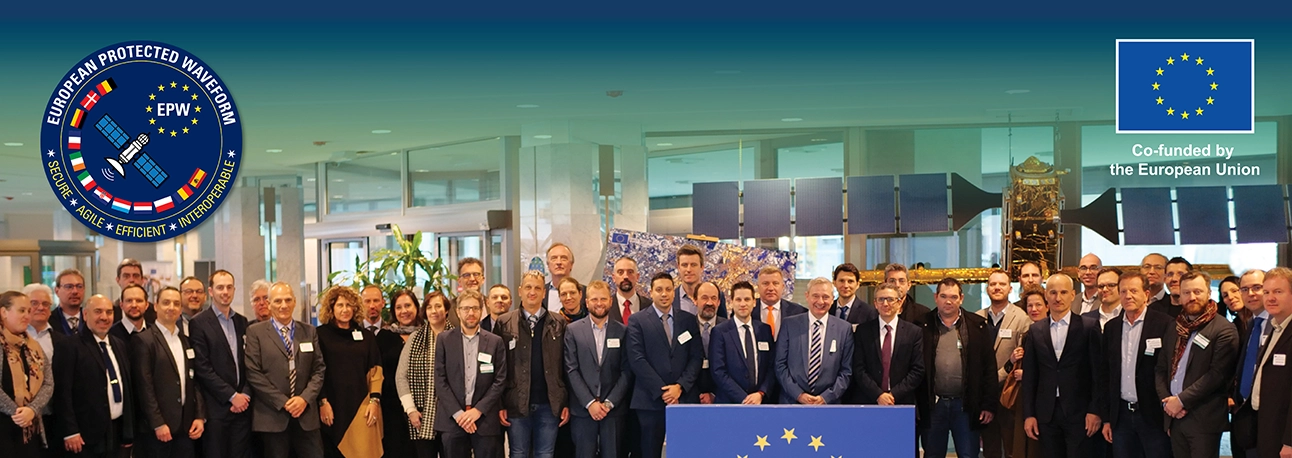The kick-off of the European Protected Waveform (EPW) Consortium happened on January 26 in Brussels; this is the start of a 39-month project during which consortium members will develop and productize the waveform for use by European nations.
In this need-to-know blog, we take you through the reasons why the EPW is necessary, what the project will entail and how European countries will ultimately benefit.
What is the European Protected Waveform?
Today, military operations are becoming more complex as conflict areas grow more dispersed on a global scale, with a growing need to support a diversity of on-the-move, on-the-pause and fixed platforms. Security threats are a growing concern from threats of jamming, interruption and ultimately endangering military operations. The challenge is to enable, in a secure and guaranteed way, the increased demand for satellite capacity for military purposes.
To tackle these security challenges an integrated multi-layered security and resiliency approach is needed with a fully “European” protected waveform and accompanying next-gen satcoms technologies.
The European Protected Waveform (EPW) is built around four cornerstones: agile, secure, affordable and interoperable satellite communications. The EPW will be developed in tandem with current and future requirements for military and secure operations. Leveraging new disruptive technologies, multi-layered security and resiliency solutions and EU initiatives such as the Pooling and Sharing program GovSatCom and the upcoming IRIS2 multi-orbit satellite constellation.
As such the EPW is accessible to European nations seeking to securely increase throughput demand over satellite, dispersed operations, mobility, and a myriad of applications.
Through disruptive innovative technology coming from key stakeholders in EU industry and universities, the EPW addresses the growing demand for European autonomy.
Who are the stakeholders involved in the project?
The EPW will be developed under the European Defense Fund program with a first phase (EDF2021 Call on Space – Resilient space-based PNT and SATCOM) studying and designing the EPW and its extended multi-layered security and resiliency solutions.
The national lead for the EPW program is managed through the Belgian Ministry of Defense with Belgian company ST Engineering iDirect’s European entity as the EPW consortium leader. The other consortium stakeholders are a mix of large companies, SMEs and universities that come from 12 nations across Europe including Belgium, Denmark, Germany, Croatia, Italy, France, Luxembourg, Netherlands Poland, Spain and Romania.
The triple helix approach to the program will ensure the waveform benefits from the shared experience and expertise of government, educational institutions, and industry for an end result that is of the highest standard.
Companies committed to the program are:
Airbus D&S, Antwerp Space, Amphinicy, Belgian Royal Military Academy, CTG Celestia, Eutelsat, Elital, GISS, Indra, NeoSat, Quadsat, Lasting, Leonardo, LuxGovSat, NLR, OHB, ST Engineering iDirect Europe, Telespazio, Thales Alenia Space and Thales Six.
“The coming together of these key companies and institutions, with their combined knowledge and experience will equip European countries with highly reliable, seamless satcoms to ensure that they can communicate with confidence and security no matter where they operate.”
– Koen Willems, ST Engineering iDirect Europe’s initiator and overall coordinator of the new program.
How long will the project run for?
The EPW Consortium will work together over a period of 39 months to study and design the EPW waveform and accompanying technologies for resilient and secure satellite communications.
How will the project be funded?
The estimated total cost for the EPW program under the EDF2021 call will be approximately 30 million euro with a 25 million Euro contribution by the EU Commission through the EDF program and 5 million Euro through a co-funding mechanism between the participating nations’ ministries of defence.
Why is the project so important?
The EPW will become Europe’s sovereign satcom waveform, future-proofing satellite capabilities for European countries and promoting interoperability across European agencies and nations ensuring its deployment in joint operations. The waveform will be agile, secure and resilient but also affordable so that smaller nations will also be able to take advantage of its capabilities.
Where can I get more information on the EPW?
EDF21_Outcome_Template (europa.eu)
Funded by the European Union. Views and opinions expressed are however those of the author(s) and do not necessarily reflect those of the European Union or the European Commission. Neither the European Union nor the granting authority can be held responsible for them.
